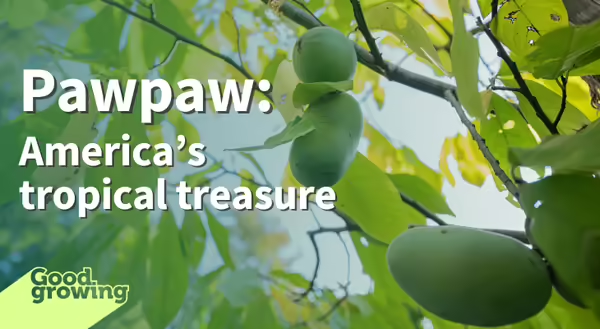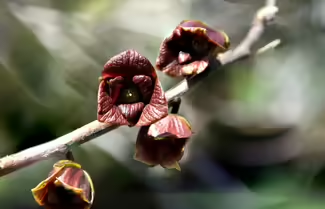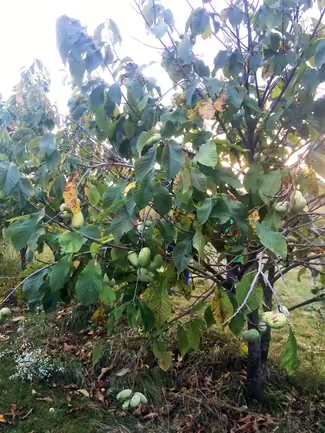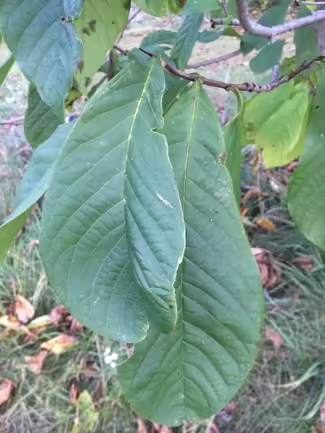
The time of year is nearing when the pawpaw (Asimina triloba) fruit will ripen and those lucky enough to have access to the fruit (and beat the wildlife to the ripened fruit) will enjoy a once-a-year delicacy. Those who have never been able to enjoy the fruit have time to search for a source.
Pawpaw
Pawpaw is a large shrub or small tree ranging in height from ten to thirty feet. It is native to Illinois, common in central and southern Illinois, and uncommon in the northern counties. Pawpaw is an understory tree found in deciduous woodlands such as those dominated by maple-linden or maple-beech. Pawpaw also inhabits woodland edges. The tree does well in cultivation and can be incorporated into a home landscape. The tree’s pyramidal habit and large leaves make an elegant statement in the landscape and have been described as having an appearance resembling magnolias.
Each spring small, 6-petaled, cup-like flowers are produced. The blooms are deep maroon and produce a subtle fragrance like rotting meat or fermenting fruits. The unusual fragrance attracts carrion beetles, blow flies, and other insects that typically feed on dead animals or decomposing plant material to aid in flower pollination. Trees are monoecious but male and female flowers mature at different times to minimize self-fertilization. To maximize harvest, more than one tree is recommended in a landscape.
In addition to fruit production, the species is a nice addition to a landscape. It has no serious pests or disease issues and is not preferred by deer. Asimina triloba is deciduous, producing yellow fall foliage prior to shedding leaves in advance of winter dormancy.
The race for ripe fruit
Pollinated flowers develop into the large, oblong fruit prized by many. Sometimes referred to as poor man’s banana, the fruit of Asimina triloba matures into a yellowish-green fruit in early autumn.
To successfully harvest the fruit, diligence is necessary. The ripe fruit is prized by wildlife and quickly eaten. Additionally, ripe fruit is highly perishable and, if left unrefrigerated, lasts only a few days. When ripe, the smooth skin of the fruit will give a little under pressure similar to that of a ripened peach. Ripening fruit may also develop black blotches, and an intense aroma. Immature fruit may be harvested and will ripen indoors at room temperature. Unripen fruit may be stored in a refrigerator for up to two weeks before being allowed to ripen at room temperature.
The flavor of pawpaw fruit is described as a banana with undertones of mango and pineapple. Cutting into ripened fruit will reveal large, dark seeds surrounded by a custard-like pulp. The seeds and the skin should not be consumed.
Pawpaw fruit is rarely available at grocery stores due to its short shelf-life. Some vendors sell the fruit at farmer’s markets, but availability and timing are tricky. There is a growing interest in pawpaw fruit and some farms are selling it directly to consumers.
Cooking with pawpaw
Pawpaw fruit can be consumed raw or utilized in the kitchen as a substitute for bananas. The consistency of the pulp lends itself to being used as an ice cream or sherbet-like treat, baked into bread and bars, or made into a freezer jam. The National Center for Home Food Preservation through the University of Georgia has instructions for making fruit leather and is another good option for pawpaw pulp.
Good Growing Fact of the Week: The common name “Pawpaw” was given by a Portuguese explorer who likened the fruit to papaya. The genus name is linked to the Algonquin word “Min” meaning fruit.
Bonus Good Growing Fact of the Week: Pawpaw is the only host plant for zebra swallowtail butterfly caterpillars.
Thank you for reading!
Sign up for our emails! Want to get notified when new Good Growing posts are available? SIGN ME UP
Give us feedback! How helpful was this information (click one): Very helpful | Somewhat helpful | Not very helpful


